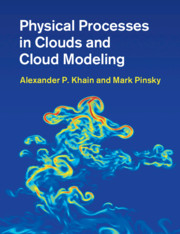Book contents
- Physical Processes in Clouds and Cloud Modeling
- Physical Processes in Clouds and Cloud Modeling
- Copyright page
- Contents
- Preface
- Abbreviations
- Symbols
- 1 Clouds: Definitions and Significance
- 2 Cloud Particles and Their Representation in Cloud Models
- 3 Basic Equations
- 4 Numerical Methods Used in Cloud Models
- 5 Warm Microphysical Processes
- 6 Microphysical Processes in Ice and Mixed-Phase Clouds
- 7 Modeling: A Powerful Tool for Cloud Investigation
- Book part
- Index
- References
4 - Numerical Methods Used in Cloud Models
Published online by Cambridge University Press: 22 August 2018
- Physical Processes in Clouds and Cloud Modeling
- Physical Processes in Clouds and Cloud Modeling
- Copyright page
- Contents
- Preface
- Abbreviations
- Symbols
- 1 Clouds: Definitions and Significance
- 2 Cloud Particles and Their Representation in Cloud Models
- 3 Basic Equations
- 4 Numerical Methods Used in Cloud Models
- 5 Warm Microphysical Processes
- 6 Microphysical Processes in Ice and Mixed-Phase Clouds
- 7 Modeling: A Powerful Tool for Cloud Investigation
- Book part
- Index
- References
Summary
Numerical methods applied in atmospheric models in general and in cloud models in particular are described in several books (Marchuk, 1974, 1980; Pielke, 2013; Mesinger and Arakawa, 1976; Durran, 2010). In this chapter we present only a brief overview of the main concepts and approaches. The pivot element of a numerical method is a system of averaged equations that describes several basic processes, among them advection of various quantities by a background wind, diffusion, gravity-inertial waves caused by the interaction of fields of pressure, and velocity in the presence of the Coriolis force, etc. (Sections 4.4 and 4.5). With the help of the splitting-up method (Marchuk, 1974, 1980; Temam, 1977), these processes can be treated successively at each time step, so the solution obtained for one process is used as the initial condition for solving the equations describing the next process. This allows for performing numerical treatment of each particular physical process separately.
- Type
- Chapter
- Information
- Physical Processes in Clouds and Cloud Modeling , pp. 122 - 150Publisher: Cambridge University PressPrint publication year: 2018



